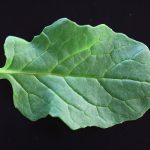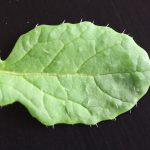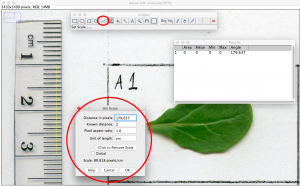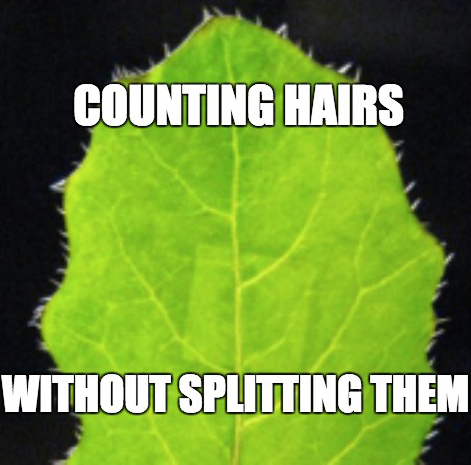Hairs are not often a trait that we associate with plants. However, of all the traits that students might observe in a population of Fast Plants, we can learn a lot about variation and natural selection by counting and selecting for the number of hairs on a leaf margin. Selective breeding to increase (or decrease) hairiness can provide an excellent opportunity for investigations into modeling evolution through “artificial” selection. In fact, selecting for this trait is the focus of AP®Biology Investigation #1.

Hairless leaf margin
The number of hairs, or “hairy phenotype,” is highly variable. A population of Fast Plants can have plants that range from nearly hairless to having hairs on all leaf surfaces, edges, and stems. Most importantly, the phenotype appears to be relatively unaffected by the environmental variables that typically vary in classrooms. For example, the number of hairs that develop on a plant does not appear to be influenced by temperature, nutrient availability (fertilizer) or light intensity.

Hairy leaf margin
So, the combination of high natural variability in Standard Fast Plant populations and resistance to environmental influences make hairiness an ideal trait for an artificial selection experiment.
With only a passing glance, students might ask what is so interesting about hairs? The answer is: they’re a wonderful mystery! Plant hairs–also known as trichomes–are not yet fully understood, but scientists hypothesize that they play a role in defense against predators, aid in the absorption of water and nutrients, and aid in the reflection of sunlight.
It may seem like a daunting task to count every hair on a plant, but fear not! Observations suggest that hairiness on one part of a plant is correlated to hairiness on other parts of a plant (i.e. a hairy plant is hairy everywhere and a bald plant is bald everywhere). It may be most efficient to count the hairs in one place on each plant, for example along the petiole or the margin of the first true leaf.
There are multiple methods that you can take to make counting hairs simple and increase accuracy. No matter which method you choose, make sure that your work area is well lit (use a bright desk lamp, if available). It may be easiest to view the hairs by back-lighting and holding the plant in front of a dark contrasting background. If available, a hand lens can be used to magnify the hairs. Alternatively, a photo snapped with a phone or iPad can be enlarged to make viewing hairs easier. Here are three techniques we like for counting hairs:
1) Count on The Plant – If you don’t wish to trim leaves off your plants, hairs can be counted by carefully viewing the first true leaf. Make sure to rotate the plant and view it from all directions to avoid miscounting hairs.
2) Remove the First True Leaf – This method is the most simple as it allows the student to easily move and rotate the leaf to take an accurate count of the hairs from all viewpoints.
3) Photograph the Leaf – Students can photograph the leaf (attached to the plant or removed) and can view the photo to count the hairs. Don’t forget to include a ruler in your photo for scale! If your school allows it, you can even have the students use their cell phones to take pictures, then counting the hairs can be homework.
If you choose to photograph the leaves, and you want to add an interesting technology element to counting leaf hairs, you can use image-processing software to take your investigation into hairiness even further. ImageJ (free for both Windows and Mac) is a piece of software that allows taking measurements from photos. One application of this could be to measure hair density of a leaf margin or petiole. Instructions for using ImageJ to measure leaf density are as follows.
1) Install ImageJ (free) http://imagej.nih.gov/ij/download.html
2) Open the image that you wish to measure
3) Set the scale
a) Use the line tool to draw a line on the ruler in your image (circled in red in the image below)
b) The line should represent a known distance (i.e. a specific number of inches or centimeters, based on the ruler in your image)
c) In the Analyze menu, click Measure
d) In the Analyze menu, click Set Scale (see image below)

e) Input your measured values (reported from step C and the known distance from B) and click OK (see image above)
4) Use the freeform line tool (circled in red in the image below) to draw a line around the object to be measured
a) In the Analyze menu, click Measure
b) Record the reported value (in the image below, ImageJ is reporting the pictured leaf to be ~15cm in perimeter)
 Sharing count data for leaf hairs is important for comparing how hairs vary in a population of Fast Plants. Graph the results from 26 or more plants, and what do you predict the shape of the graph will be?
Sharing count data for leaf hairs is important for comparing how hairs vary in a population of Fast Plants. Graph the results from 26 or more plants, and what do you predict the shape of the graph will be?
Future posts will focus on analyzing and developing explanations for these types of data.
Happy hair-counting!


